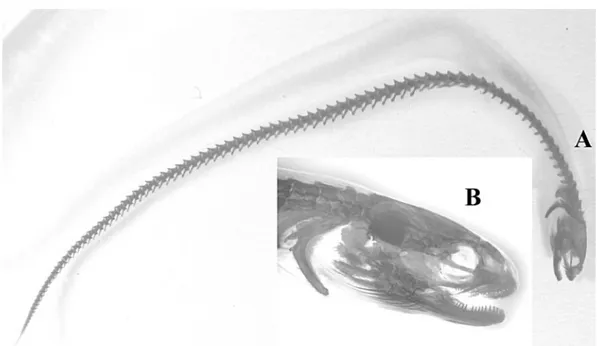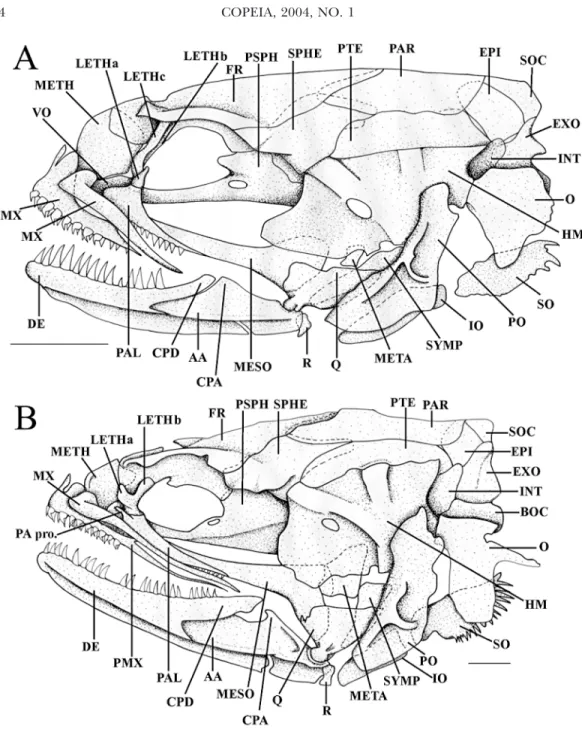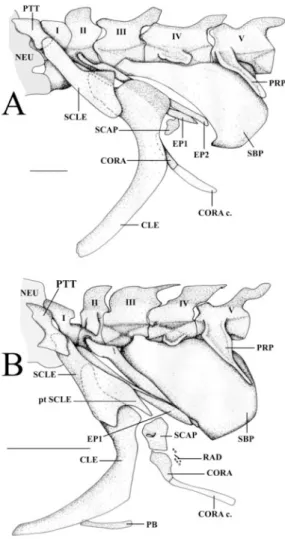COPEIA
Tuesday Nov 11 2003 01:23 PM Allen Press • DTPro System
cope 04_108 Mp_62
File # 08TQ
q 2004 by the American Society of Ichthyologists and Herpetologists Copeia, 2004(1), pp. 62–67
Encheliophis chardewalli: A New Species of Carapidae (Ophidiiformes)
from French Polynesia, with a Redescription of Encheliophis vermicularis
E
RICP
ARMENTIERA specimen of Encheliophis was found in the coelomic cavity of a sea cucumber in Moorea (French Polynesia). The skeletal morphology (skull, girdles, vertebrae) reveal it to be a new species, described herein as Encheliophis chardewalli. It is sep-arable from all described species of Encheliophis (except Encheliophis vermicularis) by the lack of pectoral fins and from E. vermicularis by the larger and fewer teeth on the lower jaw (14 vs more than 20 in E. vermicularis) and by seven branchiostegal rays (vs six in E. vermicularis).
T
HE family Carapidae contains an ecologi-cally diverse group of marine fish that are most abundant and diverse in tropical seas (Wil-liams, 1984; Parmentier and Vandewalle, 2003). Several species belonging to the generaOnuxo-don, Carapus, and Encheliophis are well known for
their unusual behavior of entering and living inside invertebrate hosts such as sea cucumbers, sea stars, or bivalves (Trott, 1981). Species be-longing to the genera Onuxodon and Carapus are commensal and species of the genus
Enche-liophis are parasites (Parmentier et al. 2000). As
determined by Parmentier et al. (2000), the ge-nus Encheliophis Mu¨ ller, 1842, contains four spe-cies: Encheliophis gracilis (Bleeker, 1856),
Enche-liophis sagamianus (Tanaka, 1908), EncheEnche-liophis vermiops Markle and Olney, 1990, and Enchelio-phis vermicularis Mu¨ller, 1842. This genus is di-agnosed by 11 synapomorphies (Parmentier et al., 2000), among which is an important field character: the maxillaries and premaxillaries united by short connective fibres to function as a unit, and both elements bound to the skin preventing large mouth openings (Parmentier et al., 1998).
Encheliophis vermicularis is distinctive among
previously known carapids in that it lacks an ex-ternally visible pectoral fin (Mu¨ ller, 1842; Mar-kle and Olney, 1990; Nielsen et al., 1999). This pearlfish, originally described from the Philip-pines, has been found in several species of sea cucumbers: in Holothuria leucospilota by Masuda et al. (1984), in Holothuria scabra by Murdy and Cowan (1980), in Holothuria lubrica by Steinbeck and Ricketts (1941), and in Thelenota ananas by Markle and Olney (1990). Records indicate that it occurs between 30 N and 30 S latitudes within the Indo-Pacific region, from the Red Sea to the Gulf of California (Markle and Olney, 1990). This species has two junior synonyms:
Enchelio-phis hancocki (Reid, 1940) and EnchelioEnchelio-phis jor-dani Heller and Snodgrass, 1903.
A specimen of Encheliophis, first attributed to
E. vermicularis because of the lack of pectoral
fins, was caught in Opanohu Bay (Moorea, French Polynesia). However, staining revealed several features that distinguish it from E.
ver-micularis, the latter of which is redescribed to
include osteological features not previously re-corded.
MATERIALS ANDMETHODS
The present specimen was compared to two specimens of E. vermicularis from New Caledon-ia (VIMS 09600, 123–148 mm SL), radiographs of the neotype of E. vermicularis (USNM 298307, 130 mm SL), holotypes of E. jordani (CAS 6345, 114 mm SL), and E. hancocki (USNM 101789, 74.8 mm SL and USNM 101790 50 mm SL; cau-dal tip is missing).
The specimen from Moorea and the two VIMS specimens were alizarin stained (Taylor and Van Dyke, 1985). The fish were examined with a Wild M10 binocular microscope coupled with a camera lucida. Measurements were made to the nearest 0.1 mm. The cephalic morphol-ogy of the genus Encheliophis has been thor-oughly described by Markle and Olney (1990), and Parmentier et al. (1998, 2000). The sound-producing apparatus is described in detail in Parmentier et al. (2003).
Encheliophis chardewalli, n. sp
Figures 1–2, 3A, 4A, 5A
Holotype.—USNM 372738, 72 mm SL, collected
on the west side of bay mouth of Opanohu Bay, Moorea, French Polynesia; E. Parmentier, 15 July 2002. It was found in the coelomic cavity of the holothuroid Actinopyga mauritania caught at a depth of 1m in the lagoon at a distance of 15 m from the beach.
Diagnosis.—In the field, separable from all
vermi-Fig. 1. Encheliophis chardewalli cleared-and-stained holotype (A), USNM 372738, 72 mm SL and (B) enlarged
view of the head (head length 5.2 mm).
Fig. 2. Type locality of Encheliophis chardewalli in Moorea (French Polynesia) marked by arrow.
cularis) by the lack of pectoral fins. Separable
from E. vermicularis by fewer, larger teeth on the dentary (14 vs more than 20 in E. vermicularis; Fig. 3) and by seven branchiostegal rays (vs six in E. vermicularis). See ‘‘Comparison’’ for fur-ther characters not observable in the field.
Description.—The head measures (from the
an-terior part of the premaxilla to the posan-terior part of the opercle) 5.2 mm. The horizontal di-ameter of the eye represents 24% of the head length, depth at the posterior end of the lower jaw is 51% of the head length and body depth at the level of the pectoral girdle is 63% of the head length.
The maxilla is toothless. Outer cardiform teeth are present at the anterior end of the pre-maxilla and small conical teeth are organized in
one row on the anterior part of the premaxilla, behind the cardiform teeth. The premaxilla and adnate maxilla are characterized by their small size and do not reach the coronoid pro-cess of the dentary. The latter and the articulo-angular coronoid process have the same height. The 14 teeth of the lower jaw are curved and arranged in a single row. They are longer and larger than those of the upper jaw. Small coni-cal teeth are arranged in two forward rows and in a single posterior row on the palatines. The vomer has a group of seven conical teeth.
Mesethmoid is large. Lateral ethmoid is U-shaped and has three shelves (Fig. 3A). Two (LETHc and LETHb) are in contact with the frontal whereas the third (LETHa) projects lat-erally. The quadrate is anterior to a vertical line passing through the anterior articulation of the hyomandibular on the neurocranium. The operculum forms a rounded plate. The hyoid arch bears seven branchiostegal rays. The me-tapterygoid is reduced and overlaps only the hyomandibular.
The body lacks pelvic, caudal, and externally visible pectoral fins. Anal fin originates behind opercle. It is longer than dorsal fin, both fins meeting at posterior tip of body. Pectoral girdle composed of three bones: postemporal, supra-cleithrum and supra-cleithrum. Cleithrum character-ised by large expansion of its dorsal part. Pec-toral fin not externally visible and made of two small bones (Fig. 4A). The coracoid possesses
64 COPEIA, 2004, NO. 1 COPEIA
Tuesday Nov 11 2003 01:23 PM Allen Press • DTPro System
cope 04_108 Mp_64
File # 08TQ
Fig. 3. Lateral view of the skull, scale bars equal 1 mm. (A) Encheliophis chardewalli, USNM 372738, 72 mm SL, Opanohu Bay, Moorea, French Polynesia; (B) Encheliophis vermicularis, VIMS 09600, 123 mm SL, Maitre Islet, New Caledonia. AA, articulo-angular; BOC, basioccipital; CPA, coronoid process of the articulo-angular; CPD, coronoid process of the dentary; DE, dentary; EPI, epiotic; EXO, exoccipital; FR, frontal; HM, hyoman-dibular; INT, intercalar; IO, interopercle; LETH, lateral ethmoid and number of the branch; MESO, mesop-terygoid; META, metapmesop-terygoid; METH, mesethmoid; MX, maxilla; O, opercle; PAL, palatine; PA pro., palatine process; PAR, parietal; PSPH, parasphenoid; PMX, premaxilla; PO, preopercle; PTE, pterotic; PTT, posttem-poral; Q, quadrate; R, retroarticular; SO, subopercle; SOC, supraoccipital; SPHE, sphenotic; SYMP, symplectic; VO, vomer.
an elongated cartilaginous ventral process and is surmounted by the small scapula.
There are 107 vertebrae, of which there are 20 precaudal vertebrae. Two first vertebrae each
bear a rodlike epineural. Third vertebra with an elongated and enlarged swim bladder plate (Parmentier et al., 2003) that covers the ante-rior part of swim bladder and reaches the fifth
Fig. 4. Lateral view of the anterior part of the ver-tebral column and neurocranium, scale bars equal 0.5 mm. (A) Encheliophis chardewalli, USNM 372738, 72 mm SL, Opanohu Bay, Moorea, French Polynesia; (B)
Encheliophis vermicularis, VIMS 09600, 123 mm SL,
Mai-tre Islet, New Caledonia. CLE, cleithrum; CORA, cor-acoid; CORA c., coracoid cartilage; EP#, epineural#; NEU, neurocranium; PB, pelvic bone; PRP, parapo-physis; PTT, posttemporal; pt SCLE, posterior tip of the SCLE; RAD, radials; SBP, swim bladder plate; SCAP, scapula; SCLE, supracleithrum; I-V, vertebral number.
Fig. 5. Lateral view of the 10th precaudal vertebra, scale bars equal 0.5 mm. (A) Encheliophis chardewalli, USNM 372738, 72 mm SL, Opanohu Bay, Moorea, French Polynesia; (B) Encheliophis vermicularis, VIMS 09600, 123 mm SL, Maitre Islet, New Caledonia. NEU SP, neural spine; PRP, parapophysis.
vertebra. Fourth epineural highly reduced and overlies swim bladder plate. From the fifth ver-tebra, all other precaudal vertebrae bear on each side a short parapophysis (Fig. 5A). The neural spines of these vertebra are short and nearly horizontal.
The body is dark blue with melanophores concentrated at the posterior end of the body and of the anal and dorsal fin. A translucent area is present behind the opercle and marks the anterior end of the swim bladder.
Melano-phores are present on the brain but are absent from the jaws and opercle. From a dorsal view, it is possible to discern the sagittae.
Etymology.—Encheliophis chardewalli is the
combi-nation of the names of Dr. Chardon M. and Dr. Vandewalle P. of the University of Lie`ge (Bel-gium). It is in recognition of their scientific ac-complishments in ichthyology.
Redescription of Encheliophis vermicularis Mu¨ller 1842.—Encheliophis vermicularis is described in
Mu¨ ller (1842), Trott (1970), Murdy and Cowan (1980), Markle and Olney (1990). However, these descriptions principally concern morpho-metric and meristic data. The features that ap-pear in this study have not been described pre-viously and are used for the comparison with E.
chardewalli.
Outer cardiform teeth and an inner row of small conical teeth are present on the anterior end of the premaxilla. The premaxilla and the adnate maxilla reach the posterior end of the eye (Fig. 3B). Its dentary bears 22–23 conical teeth in a single row but some smaller teeth on two rows posteriorly, on the coronoid process. The latter is higher than the articulo-angular coronoid process.
Small mesethmoid. Lateral ethmoid U-shaped and composed of two shelves, the first (LETHa) projects laterally and the second is in contact with the frontal (LETHb). Quadrate-mandible articulation behind a vertical line passing through the anterior articulation of the
66 COPEIA, 2004, NO. 1 COPEIA
Tuesday Nov 11 2003 01:24 PM Allen Press • DTPro System
cope 04_108 Mp_66
File # 08TQ
hyomandibular on the neurocranium. Opercu-lum V-shaped with its lower part enlarged. The hyoid arch has six branchiostegal rays. Metap-terygoid enlarged and overlapping the mesop-terygoid and the hyomandibular.
The supracleithrum possesses a caudo-ven-trally oriented posterior tip (Fig. 4B; see also Williams 1984) and covers a great part of the cleithrum. Pectoral fin composed of large bones and small proximal radials are visible (Fig. 4B). The vertebral columns of the two VIMS spec-imens have 123 and 117 vertebrae, respectively. First two vertebrae each bear a rodlike epineu-ral rib. Third vertebra has an elongated and en-larged swim bladder plate that covers the ante-rior end of the swim bladder and reaches the fifth vertebra (Fig. 4B). From the fifth vertebra on, all other precaudal vertebrae bear on each side a parapophysis longer than the vertebral body. Their neural spines appear more vertically than horizontally oriented. Between the right and left cleithra, two small rodlike bones cor-respond to reduced pelvic bones.
At the level of the lateral line, these speci-mens have on each side a small scale per ver-tebra until the 70th verver-tebra.
Comparison.—Encheliophis chardewalli is
distin-guished from E. vermicularis by at least 14 char-acters: (1) the premaxilla and the maxilla are proportionately shorter; (2) the lateral ethmoid possesses three shelves (vs two); (3) teeth of the dentary are proportionally larger and fewer (14 vs more than 20); (4) the opercular bone is rounded (vs V-shaped); (5) the hyoid arch bears seven branchiostegal rays (vs 6); (6) the supra-cleithrum does not have an elongate posterior tip; (7) the neural spine of the first vertebra is larger and rounded; (8) lack of pelvic bones; (9) lack of scales; (10) pectoral bones (scapula and coracoid) reduced; (11) neural arches and parapophysis reduced; (12) larger mesethmoid; (13) reduced metapterygoid and (14) shorter coronoid process of the dentary.
DISCUSSION
The dentition of the thin premaxilla (outer cardiform teeth and an inner row of small con-ical teeth), and the presence of the adnate max-illa, which is bound by skin to the head, show that this specimen belongs to Encheliophis follow-ing the diagnosis proposed by Parmentier et al. (2000). Encheliophis chardewalli could be a pae-domorphic form given that its skeletal mor-phology has a series of features that seem to exhibit arrested development. (1) Studies of de-velopment in five carapids genera show a trend
to an increasingly posterior placement of the quadrate-dentary articulation (unpubl. data). In
E. chardewalli, the more forward position of the
quadrate-dentary articulation and the more leaning operculum could be the result of ar-rested development. (2) Arar-rested development might also explain the more regular form of the opercle in E. chardewalli, which is otherwise V-shaped in all other Carapidae (Parmentier et al., 2000), even in the Carapini tribe (Carapus and Encheliophis) larvae (Parmentier et al., 2002). (3) The pectoral fin is less developed and the pelvic bones are missing in E.
charwalli. (4) The upper jaws appear to be less
de-veloped than in all other Carapidae (Markle and Olney, 1990; Parmentier et al., 2000).
However, other characters show that the spec-imen described in this study can not be the lar-val or juvenile form of E. vermicularis. For ex-ample, all bones of the neurocranium and sus-pensorium found in other adult carapids are present in E. chardewalli, and are well ossified and characterized by major overlaps (Parmen-tier et al., 2002). The lateral ethmoid has three shelves in E. chardewalli; a feature shared by all the Carapini except E. vermicularis and E.
graci-lis. Encheliophis chardewalli also shows
better-de-veloped conical teeth on the dentary. ACKNOWLEDGMENTS
I thank J. Million, Y. Chancerelle, and J. Al-gret (CRIOBE) for helping to obtain carapids in Moorea. I am grateful to S. Jewett and S. Ra-redon (USNM), to D. Catania (CAS) for giving X-ray photographs, and to J. E Olney (VIMS) for giving E. vermicularis specimens. J. T. Wil-liams (USNM) kindly commented on an earlier version of this text. All collecting and handling of specimens was in accordance with policies and recommendations of University of Liege. This work was supported by grant 2.4560.96 from the Fonds National de la Recherche Scien-tifique of Belgium.
LITERATURECITED
MARKLE, D. F.,ANDJ. E. OLNEY. 1990. Systematics of
the Pearlfish (Pisces: Carapidae). Bull. Mar. Sci. 47: 269–410.
MASUDA, H., K. AMAOKA, C. ARAGA, T. UYENO,ANDT.
YOSHINO. 1984. The fishes of the Japanese
Archi-pelago. Tokai Univ. Press, Tokyo, Japan.
MU¨ LLER, J. 1842. Beobachtungen u¨ber die schwimmb-lase der Fische, mit bezug auf einige neue fischgat-tungen. Arch. Anat. (Mu¨ller) Jahr 1842:307–329. MURDY, E. O.,ANDM. E. COWAN. 1980. Observation
pearlfish Encheliophis vermicularis (Osteichthys: Car-apidae). Kalikasan Philippine J. Biol. 9:309–312. NIELSEN, J. G., D. M. COHEN, D. F. MARKLE,ANDC. R.
ROBINS. 1999. FAO species catalogue. Vol. 18. Ophi-diiform fishes of the world (order OphiOphi-diiformes). An annotated and illustrated catalogue of pearlfish-es, cusk-eels, brotulas and other ophidiiform fishes known to date. FAO Fish. Synop. 125:1–178. PARMENTIER, E.,ANDP. VANDEWALLE. 2003.
Morpho-logical adaptations of Pearlfish (Carapidae) to their various habitats, p. 261–276. In: Fish adaptations. A. L. Val and B. G. Kapoor (eds.). Oxford. ———, M. CHARDON, M. POULICEK, J. C. BUSSERS,AND
P. VANDEWALLE. 1998. Morphology of the buccal ap-paratus and related structures in four Carapidae. Aust. J. Zool. 46:391–404.
———, G. CASTILLO, M. CHARDON,ANDP. VANDEWAL
-LE. 2000. Phylogenetic analysis of the pearlfish tribe Carapini (Pisces: Carapidae). Acta Zool. 81:293– 306.
———, A. LO-YAT,ANDP. VANDEWALLE. 2002. Identi-fication of four French Polynesia tenuis Carapini (Carapidae: Teleostei). Mar. Biol. 140:633–638. ———, P. VANDEWALLE, AND J.P. LAGARDE` RE. 2003.
Sound producing mechanisms and recordings in
Carapini species (Teleostei, Pisces). J. Comp. Phy-siol. A 189:283–292.
STEINBECK, J.,ANDE. F. RICKETTS. 1941. Sea of Cortez. Viking Press, New York.
TAYLOR, W. R., ANDG. C. VAN DYKE. 1985. Revised procedure for staining and clearing small fishes and other vertebrates for bone and cartilage study. Cybium 2:107–119.
TROTT, L. B. 1970. Contribution of the biology of car-apid fishes (Paracanthopterygian: Gadiformes). Univ. Calif. Publ. Zool. 89:1–41.
———. 1981. A general review of the pearlfishes (Pi-sces, Carapidae). Bull. Mar. Sci. 31:623–629. WILLIAMS, J. T. 1984. Synopsis and phylogenetic
anal-ysis of the pearlfish subfamily Carapinae (Pisces: Carapidae). Bull. Mar. Sci. 34:386–397.
LABORATOIRE DEMORPHOLOGIEFONCTIONNELLE ET EVOLUTIVE (LMFE), BAT. B6, UNIVERSITY OFLIE` GE, BELGIUM; AND CENTRE DE RECHER -CHE INSULAIRE ET OBSERVATOIRE DE L’ENVIRONNEMENT, C.R.I.O.B.E/E.P.H.E., B.P. 1013, MOOREA FRENCH POLYNESIA. E-mail: e.parmentier@ulp.ac.be. Submitted: 9 April 2003. Accepted: 16 Aug. 2003. Section editor: D. G. Buth.


